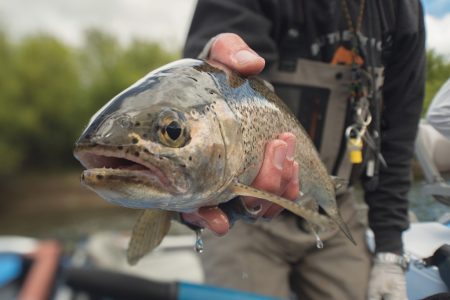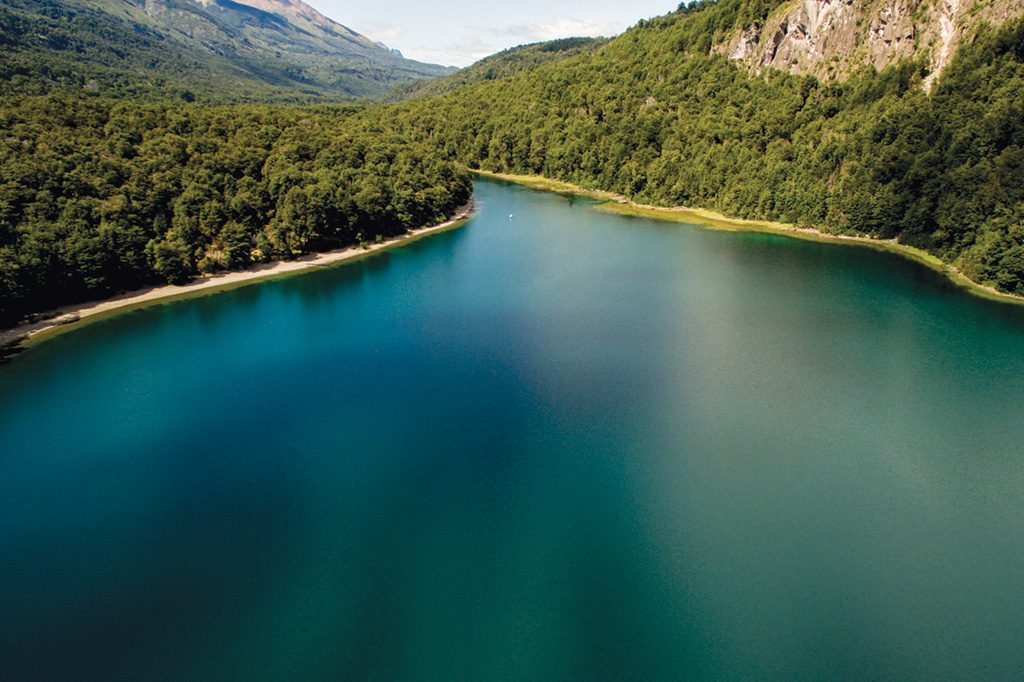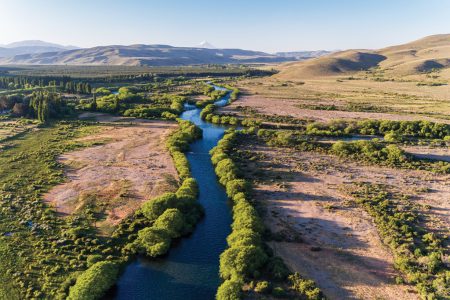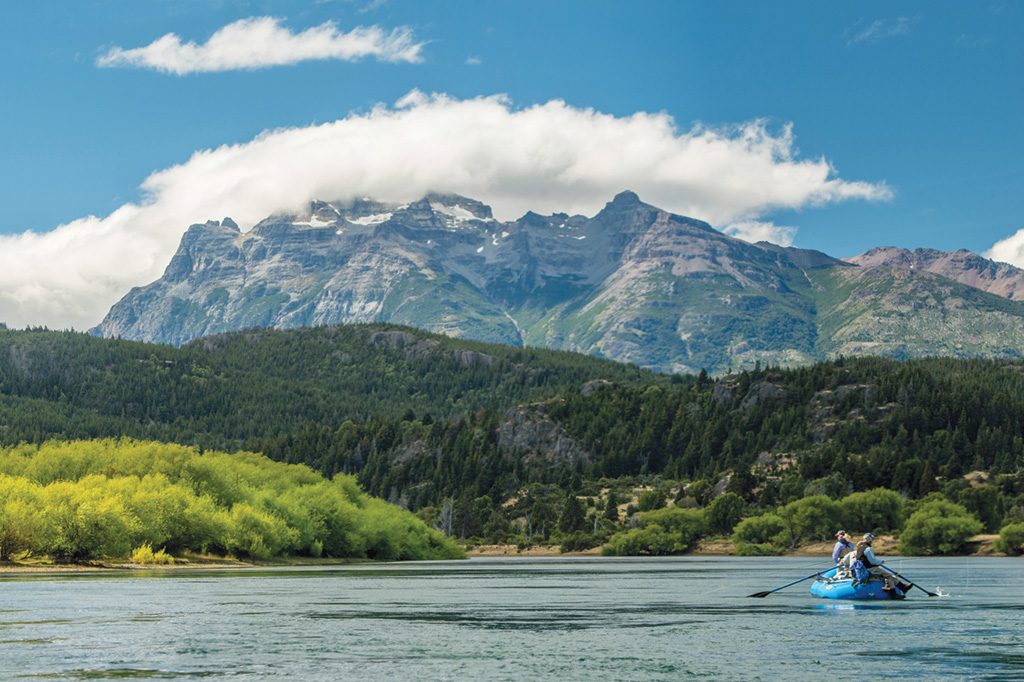South of the equator, there is a mythical landscape of hanging glaciers and sharp, windswept peaks rising above an arid expanse of vast grassy plains, the Argentine pampas, that frames deep river valleys flowing clear and strong. The rivers twist and turn through the Andes, gathering in riffles and pools the color of topaz and jade where the flickering shapes of trout, shadowy and elusive, flash and sip from below.
This is Patagonia, a vast region, neither province nor nation, which straddles both Argentina and Chile and encompasses over 260,000 square miles of pristine mountains, rivers, grasslands and steppes. It is a landscape at once foreign and eerily familiar to anyone from the American West—where the high mountain desert, winding spring creeks, jagged peaks and impressive expanse call to mind the topography of Idaho, Wyoming, Montana, which is perhaps no accident, since both areas are nearly equidistant from the equator. The town of Trevelin, Argentina, resting along the central spine of the Patagonian Andes, sits at the near exact southern equivalent of Sun Valley, Idaho (Sun Valley’s latitude is 43.6971˚ North, while Trevelin lies at 43.0888˚ South).
It is a wild and remote landscape that bears similarities to the American frontier over 100 years ago. In fact, Patagonia is believed to have been the last place that humans arrived in the Americas and, with just five people per square mile, remains today one of the most secluded locations on earth. It is a place where the fish and wildlife far outnumber the resident human population.
Trout were introduced to the region from the U.S. in 1904, thriving in the cold, clear glacier-fed water and growing large on the abundant aquatic life. The rivers in Patagonia are literally teeming with an impressive line-up of freshwater fish, including resident brown, rainbow and brook trout, and the fabled sea-run brown trout of Tierra del Fuego, which is a bit of a scientific anomaly, having developed into an anadromous run after introduction in the 1930s. Combine that with the smoldering volcanoes and spectacular scenery, a rich and diverse culture that values adventure, good food, fine wine, and festive gatherings and you have just created the perfect winter escape from any snow-packed and ice-covered driveway.
Argentines are both a proud and passionate culture—they relish public displays of emotion, sing out loud at all times of the day and night, brazenly ignore all stop signs, cry openly in public and embrace dance as a means of seduction and storytelling (originating in Buenos Aires in the 18th century, the Tango is the national dance of Argentina). They are also an open and genuine people with a relaxed demeanor that is intertwined with a pioneering spirit and a strong sense of adventure (much of the country was founded by descendants of European noble families looking to extract the natural resources of the land).
“Argentines live in the moment,” said Gaia Macchiavello, a native Argentinian, whose family originally came from Italy and who owns and operates LOL Argentina, a travel concierge providing full travel booking services, as well as city tours, transfers, and airport meet and greet services. “They don’t think about what has happened, or they would be suicidal.” Gaial cites the coup, years of civil war, several deep recessions, the politics, “and they don’t worry over tomorrow, you can’t change it anyway.”
Nothing is rushed in Argentina. Time slows and conversations expand, meandering like the Arroya Pescado, a gorgeous spring creek along the Patagonian steppe outside Esquel, so that you may find yourself losing track of time along a riverbank, weaving conversation around the passing of a mate cup, the local tea brewed from the leaves of an evergreen shrub related to holly. In fact, fly fishing in Argentine is touted as one of the best vacations for serious anglers and non-anglers alike because of the many other activities available for those wishing to take a break from fishing: horseback riding across the estancias (large Argentine family-owned ranches) in the tradition of the gauchos, wine tasting, hiking, cultural tours, bird watching, national park tours, museum visits, or simply hiking and soaking up the spectacular scenery.
But I am, above all, an angler, and I came to Argentina to fish. So, just two days after landing, after a quick stop in the beautiful and cosmopolitan capital (Buenos Aires has been called “the Paris of the South”) to tour the cultural sites, take a deep dive into history and enjoy some incredible food and wine, my husband, Pete, and I jumped a flight to Esquel, in the heart of the Argentina’s Welsh settlement for five days of fishing on five different rivers from Patagonia River Guides’ (PRG) Lodge at Trevelin.
 During those five days, we floated dry flies to big rainbows, slung heavy streamers on sinking line from a drift boat across the Rio Grande in search of monster browns striking like a locomotive, sight-fished along a walk-and-wade spring creek into clear pools of rising fish beneath the shade of weeping willow and an abundance of fragrant wild mint, and bounced hoppers, stripping off the banks of the Rio Corcovado near the border with Chile as it flows, fast and clear and tight out of the Lago Vinter, one of the largest lakes of the region. The Corcovado was one of my favorites for the variety, alternating between deep cliff-lined pools and corners with views to the snow-capped peaks, and exciting whitewater sections with decent drops; and also because it was the river where I landed my first 24-inch brown, stocky and hard fighting due to living in this fast flowing river.
During those five days, we floated dry flies to big rainbows, slung heavy streamers on sinking line from a drift boat across the Rio Grande in search of monster browns striking like a locomotive, sight-fished along a walk-and-wade spring creek into clear pools of rising fish beneath the shade of weeping willow and an abundance of fragrant wild mint, and bounced hoppers, stripping off the banks of the Rio Corcovado near the border with Chile as it flows, fast and clear and tight out of the Lago Vinter, one of the largest lakes of the region. The Corcovado was one of my favorites for the variety, alternating between deep cliff-lined pools and corners with views to the snow-capped peaks, and exciting whitewater sections with decent drops; and also because it was the river where I landed my first 24-inch brown, stocky and hard fighting due to living in this fast flowing river.
And while the fishing is exciting in Patagonia, there are plenty of times when you can’t help but sit back and just absorb the scenery—even if it only happens during the siesta-like riverside break for lunch, which, with the assistance of the PRG guides, is a sumptuous multi-course meal with tables and chairs, a tablecloth and plenty of the local Malbec on hand.
On the third day, we drove the short distance to Los Alerces National Park to fish the Rio Rivadavia. Considered the crown jewel of Argentine fishing, the Rivadavia is easily one of the most beautiful rivers I have ever fished, with crystal clear glacier-fed water in shifting colors of emerald and aquamarine, long limbs and mosses from the Arrayanes rainforest swirling tendrils in the currents while dense stands of the 3,000-year-old Alerces (a type of sequoia) marched up the mountainside of the Valdivian rainforest. It was truly breathtaking, with challenging sight fishing to large rainbows, browns, brook trout and
landlocked salmon.
An angler could spend years exploring the rivers around Trevelin and Esquel, but after five glorious days we headed north towards San Martin de los Andes and Bariloche to fish private waters from the estancia at Tipiluke, a quartet alone on the river, fishing riffles and pools along the private lands through the relationships of PRG North guide and partner, Alex Knull. Knull, who was born in San Martin de los Andes and caught his first fish on a fly rod at the age 9, comes from a long line of anglers— his great grandfather, Guy Dawson, was one of, if not the first, guide in the region. He arrived from Australia in the 1930s as an expert on Merino sheep and caught the first few salmon on the Traful River while managing Estancia La Primavera (now owned by Ted Turner), before quickly realizing the world-class fishing he had stumbled upon and building a hotel in San Martin de los Andes as lodging for guests, thus becoming one of the first outfitters in the country. Knull’s great uncle and uncle followed suit, so it runs in the blood. These are Knull’s home waters, and he knows them well.
Our first adventure was to drop down out of the mountains onto the Patagonian steppe to spend three days with Alex and his team of guides on the Limay River as part of the PRG Unplugged experience, a multi-day tented camp trip. Far from roughing it, this experience included a professional chef preparing delicious meals like homemade pizza, paella and fresh cut salads, as well as amenities like hot showers, comfy cots and tents set up before your arrival, with bonbons on your pillow after dinner and a solar lighting system. The stars thrown across the sky the first night of our riverside camp, parrots calling from the trees, and sunsets painted across the open desert landscape and melting into the river in the evenings very nearly overshadowed the sheer abundance and size of the fish caught on dries, nymphs and streamers. Almost. Because the fishing was that good.

The Rio Rivadavia flows through the Valdivian rainforest into the Arrayeanes River and the Rio Frey.
While abundant and prolific, fishing in Argentina is not for those not ready to learn to: cast into the wind if necessary, fish to trout holding in pools so clear they reflect the sky or to throw heavy streamers 100 feet or more to the bank, stripping hard back to the boat. I learned to trust that I could make the cast the guide asked of me, or at least try (and try again if I missed the first time) and I learned to sit back, share a bottle of wine over lunch, talk politics (yes, politics) with curiosity and unattached speculation, and to live a little more in the moment each day.
Critical to those experiences were the genuine engagement and expertise of the guides we connected with along the way, all of it masterminded by Rance Rathie and Travis Smith, best friends from Sheridan, Mont., who first came to Patagonia as fishing guides 25 years ago. Fast forward to 2001, when the two had developed reputations as expert guides adept at navigating the Patagonia waterways and locating fish, then Rathie married his Argentine sweetheart, settling into life south of the border, and Rathie and Smith started their own business.
“Our focus from the start has been simple: fish the best rivers in central and northern Patagonia, at the best times, with the best guides,” stated Travis. “We want to give our guests the best opportunity to catch fish in any possible situation and have a first class experience while doing it.”
Today, PRG has become a leader in high quality, customized fly fishing programs covering over 10 diverse fly fishing lodges and serving more than 50 different rivers and locations. Most of their guides have been fishing seriously since their teens, or earlier, grew up locally, and come with decades of experience on local rivers. In a testament to the business the two Montana boys have started, most of their guides have been guiding with PRG for since the beginning—for 18 years or more.
Rathie and Smith have embraced the culture, and they offer a piece of it to their guests: through the expertise of their local guides, through the art on their walls (from revered Argentine landscape artist Georg Miciu, a close friend, whose museum in Bariloche is a familiar tourist stop), and through their collaboration with a consortium of five local winemakers hoping to create wine that reflects the terroir of their region (their 2018 wines just received 90 and 91 point rating from the well-known wine critic Tim Atkin).
The PRG experience is a unique blend of inspiring water, varied fishing, beautiful scenery, interesting culture, lasting friendships and unrivaled service, complemented by gourmet regional cuisine, fine wines and first-class accommodations. There is great attention to every detail, and yet, in true Argentine fashion, a relaxed and welcoming atmosphere. They understand that fishing is about so much more than catching fish.
Fishing is about the telling of stories and sharing in the magic of rivers. More than oceans, even, rivers seem to be the stringing together of stitches in time, constantly moving, and strung deftly moment by moment and pasted with the imaginings of what hovers just beyond reach, imagining what the next cast or corner or water may, perhaps, bring.

The Rio Chimehuin flows through estancia Cerro de los Pinos at Tipiluke Lodge. The snow-capped Lanin Volcano is in the distance.
I have never met another fisherman who wasn’t a storyteller. And not in the way you would imagine—of fish that grow larger once they leave the net, but in the gathering of moments and the recasting them as an adventure that is here, now, with great character and power. Fishing necessitates being in the present moment, even as it conjures the movement of time; a thought that brings to mind my favorite quote of the trip, from PRG North guide Alex Knull.
“The thing about time is that it is always moving, “ he said, quite simply while standing beside me in the Rio Malleo one afternoon. “Just like a river, it is passing and passing … and, pretty soon, the thing you were worried about is already in the past, and then you are not worried about it any more.”
Agreed. My only worry at this point is how to get back to experience more of Patagonia and the rivers and adventures of PRG again in
the future.



